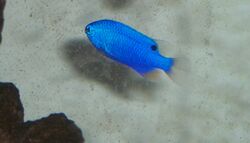Biology:Chrysiptera cyanea
| Chrysiptera cyanea | |
|---|---|

| |
| Scientific classification | |
| Domain: | Eukaryota |
| Kingdom: | Animalia |
| Phylum: | Chordata |
| Class: | Actinopterygii |
| Family: | Pomacentridae |
| Genus: | Chrysiptera |
| Species: | C. cyanea
|
| Binomial name | |
| Chrysiptera cyanea Quoy & Gaimard, 1825
| |
| Synonyms | |
|
List
| |
Chrysiptera cyanea is a species of damselfish found in the wide Indo-West Pacific but not known in the Red Sea.[2] A few individuals were observed in the Mediterranean Sea in 2013 off Slovenia, a likely aquarium release.[3]
Common names include blue damselfish, blue demoiselle, blue devil, cornflower sergeant-major, Hedley's damselfish, red tail Australian damsel, sapphire devil, and sky-blue damsel.[4]
Description
This fish reaches 8.5 centimeters in length. It is bright blue in color; the male has a yellow snout and tail, and the female and juvenile usually lack yellow but have a black spot at the base of the back edge of the dorsal fin.[2][5]
Behavior
The fish inhabits reefs and lagoons. Its diet includes algae, tunicates, and copepods. Male and female pair up for breeding, and the male guards and tends the eggs.[2]
In aquarium
It is very aggressive. A matched couple often attacks any same size fish approaching its breeding territory.[5]
References
- ↑ Allen, G.R.; Arceo, H.; Mutia, M.T.M.; Muyot, F.B.; Nañola, C.L.; Santos, M. (2022). "Chrysiptera cyanea". IUCN Red List of Threatened Species 2022: e.T188435A1874753. doi:10.2305/IUCN.UK.2022-2.RLTS.T188435A1874753.en. https://www.iucnredlist.org/species/188435/1874753. Retrieved 1 January 2024.
- ↑ 2.0 2.1 2.2 Froese, Rainer and Pauly, Daniel, eds. (2011). "Chrysiptera cyanea" in FishBase. April 2011 version.
- ↑ Atlas of Exotic Fishes in the Mediterranean Sea (Chrysiptera cyanea). 2nd Edition. 2021. 366p. CIESM Publishers, Paris, Monaco. https://ciesm.org/atlas/fishes_2nd_edition/Chrysiptera_cyanea.pdf
- ↑ Froese, R.; Pauly, D., eds (2011). "Common names of Chrysiptera cyanea". http://www.fishbase.org/comnames/CommonNamesList.php?ID=5695&GenusName=Chrysiptera&SpeciesName=cyanea&StockCode=5988.
- ↑ 5.0 5.1 Youtube <<Advance Marine Aquarium>> Creatures section, Damselfish - Author:Sublanding Fish[2020-06-19]
External links
- Photos of Chrysiptera cyanea on Sealife Collection
Wikidata ☰ Q1123833 entry
 |


